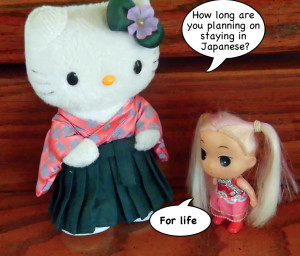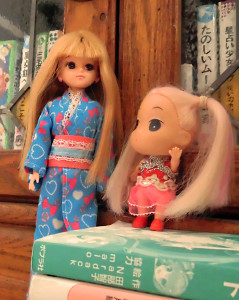 One of the greatest enemies of learning Japanese can be – studying Japanese.
One of the greatest enemies of learning Japanese can be – studying Japanese.
You can’t learn a language by studying it. You can only learn about a language by studying it.
Am I saying you should never study? No, of course not. What I am saying is that study should not be at the center of your effort to learn Japanese. Study is a support to learning.
How much of it you do will vary depending on your approach. It can (and I think should) be a lot less than most people think. But one thing is certain. If all you do is study, you won’t learn Japanese.
When I say that learning Japanese should be like a game, here is what I mean. Imagine a big, complicated game. A really big game. There is a ton to learn in this game.
Now imagine someone who sets out to learn everything (or at least a very large proportion of the information) about the game before she ever touches the controller.
Six months in and she is still trying to memorize the names, characteristics, and elemental types of 1,893 monsters. Nine months in and she is working on the finer points of battle strategy. By a year she is tackling the intricacies of breeding monsters. She still hasn’t touched the game except for practice sessions in the game’s tutorial levels. It all feels terribly abstract and difficult.
Now there may be people who learn well that way. But I think the best approach is to start the game as soon as you know enough to begin. You will encounter monsters, battles and everything else as you go along. You can learn them as you need them. I am not saying this is easy. Learning Japanese is always going to take work. But it is going to make sense and feel like language rather than a set of words and rules.
We suggest that you learn the basics of grammar in a simple way, and then plunge in to using Japanese by watching anime with Japanese subtitles and other real Japanese (non-textbook) activities.
Let’s take some simple examples of how study can become an obstacle to learning.
I have heard people say that as they advance grammar becomes an increasingly complex set of rules that they forget as fast as they learn.
I am not surprised. Grammar should not primarily be learned as abstract rules. You should be using the language and making friends with the way it is used. The rules are not just abstractions to be learned. You need to get comfortable with them, hear them often, get the real-life feel of them. Trying to learn a hundred rules before having the real-life feel of even one is learning upside down.
You can simplify these “masses of rules” hugely by learning how Japanese really works as opposed to the complicated back-to-front approach the textbooks teach. But even that doesn’t substitute for really using the language.
People complain that one word may have ten definitions. How can they learn them all?
We shouldn’t be learning a list of definitions. We should be making friends with the words. We don’t need to learn a whole list of the ways a word can be used. All we need is to understand the way it is being used right now (in the anime we are watching or the book we are reading). We can enter that word into an application like Anki to help us learn it (especially its kanji). But we need to get familiar with that use.
Later on we will see the word used in other ways. We will see the relationship between the different uses. For example, how 切る kiru, to cut, has many extended meanings (Denshi Jisho lists 24) but all of them are based around the metaphor of cutting. Trying to learn them as a list is completely the wrong way to approach them. Just learn them as they come, and the feeling of how the word works will get clearer and clearer over time, just as it does for children.
This last part may take quite a while. It takes children a long time too. The subtleties of the language start falling together in our minds as we use it and use it. It doesn’t need to be rushed. It doesn’t help anything to try to rush it. We just end up with lists of abstractions in our minds that don’t make real sense. Because only making friends with words, grammar and the language as a whole makes real sense of them.
Now having said all this, I have to say that it does depend on what you have entered the world of Japanese for, and how long you plan to stay.
Our immersion approach is based on the assumption that you plan to stay for life. If you are cramming for an exam, you may be better off with lists of rules and lists of vocabulary and all the apparatus of “study”. You won’t learn Japanese, but you will learn a lot about Japanese, and that is what exams are for.
But if you are entering a life-long relationship with Japanese and planning to make her your Second Mother Tongue, the “primacy of study” can become your biggest obstacle. The idea that you spend many months or even years “preparing” before you use the language, for you, is flawed from the beginning.
In our article on how to build a Japanese core vocabulary organically, we gave the example of the person who asks:
How many “core vocabulary” words do I need to learn before I can read manga?
We explained how this approach often leads to disappointment and burnout. But more than that, for Second-Mother Tongue learners it is psychologically the wrong approach. It is developing the wrong relation to the language, as a “subject of study”.
The right question here is:
How much core vocabulary will I learn from reading this manga?
Actually, of course, we do not even ask this question. Our primary objective is reading the manga itself. We are using Japanese, not studying it. The fact that we are “learning core vocabulary” is just a magnificent by-product. Magnificent because it will make it that much easier to read the next manga, and the next, and to watch the next Japanese-subtitled anime, and to do whatever else we do.
Everything we do in Japanese feeds into everything else we do in Japanese. This is how we learn rather than “study”.
The whole “cult of study” can lead to what are, for the Second-Mother Tongue learner, bad practices. For example, if we are doing massive input we do not need to and should not put all our new vocabulary in Anki.
Why not? for two reasons:
- We should not be thinking in terms of “study” as the primary way forward. We will pick up words if we are immersing and using massive input. By the time we reach a middling intermediate stage, Anki is for learning words that we feel need a special boost and words that contain unfamiliar kanji (because kanji are a special case).
- We need to get over the “fear of forgetting”. We will temporarily forget some words we learn. But this is not our “only chance” to learn them. We will be encountering them again and again. We are in Japanese for the long haul, not cramming for an exam. We need to give the majority of our Japanese time to massive input (and output). Study is useful up to a point but it can easily suck time away from the real thing. (Of course this only works if your input is truly massive.)
So, after basic grammar, should we never study? This is a matter of personal learning style. But I think a Second-Mother Tongue learner, when she does study, takes a rather different approach.
For example, I read A Dictionary of Intermediate Japanese Grammar for fun. I didn’t try to “learn” it. It may seem odd, reading it for fun, but remember our game analogy. When you love a game, you don’t put off playing it until you have learned a huge amount about it. But you may well read everything about the game you can get your hands on when you aren’t actually playing it. If you love playing the game, everything that helps you understand the game more deeply is a good read!
One caution here. While deepening our understanding of Japanese is a good thing, reading about Japanese in English can quickly become a bad habit. Do deepen your understanding with a few really good books (the dictionaries of Japanese grammar mentioned above are highly recommended if you are a bit of a grammar nerd like this doll). Do, of course, look up grammar on the Web or elsewhere when you don’t understand it.
For general browsing once you reach the intermediate level, it is a good idea to move it into Japanese as far as possible. I strongly recommend Nihongo no Mori N3 and N2 lessons on YouTube. These videos teach Japanese grammar in a conversational, entertaining manner and all in Japanese, you are in fact learning some Japanese at the same time as learning about Japanese.
But, a final caution. Don’t ever mistake reading English about Japanese for learning Japanese. Don’t think that by reading this site, or any other English-language site, you are learning Japanese. You aren’t. If you are reading to learn something you specifically need to know it can be useful. But more than that is just a distraction from actually learning Japanese.
Again it depends if you are a Second-Mother Tongue learner. If your heart-base is in English and Japanese is a hobby on the side, by all means have fun with your hobby in English.
But if Japanese is where you are going, don’t for a moment think that “playing Japanese” in English is getting you there. If Japanese is like exercise, then every minute you are not doing something in Japanese is like getting off the treadmill, and reading about Japanese in English (except for the occasional necessary and brief clarification) is like getting off the treadmill and eating cake.
But Japanese only feels like a treadmill because we are still basing ourselves in English. The aim of the Second-Mother Tongue learner is to move that emotional base into Japanese.
And that takes effort. From struggling through your first anime to struggling to put your inner monologue into Japanese, acquiring Japanese takes ganbari, just as struggling to understand and express yourself in your first language took ganbari (that is one reason very small children often seem so cross-grained and frustrated). Study takes ganbari too, but it is a different kind of ganbari.
So is this site a distraction from acquiring Japanese too? Too much of it would be. Our aim is to provide the information and encouragement needed for true immersion and share some of the methods that have helped us on the way.
But the main Cures behind this site communicate among themselves almost exclusively in Japanese. We also started the Kawaii Japanese Forums so that other people could communicate in Japanese rather than use English-language “Japanese forums”. This is all part of the philosophy of using Japanese rather than studying Japanese.
We hope this site will help you to plunge into the big, deep, scary-but-wonderful world of real Japanese outside the textbooks. And we hope to meet you there some time!











